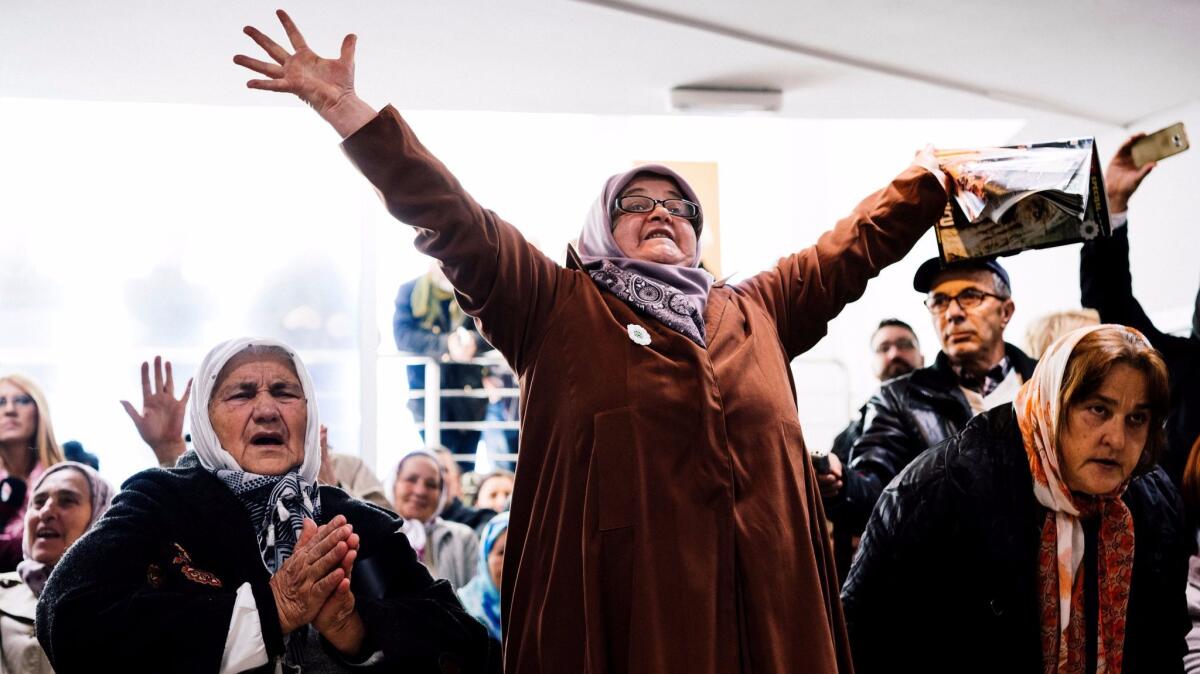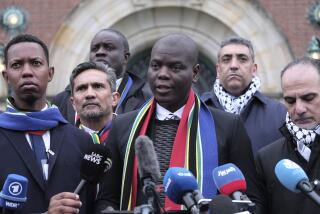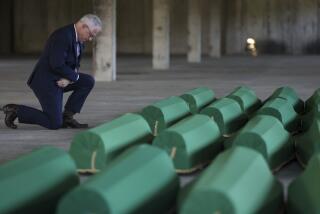Genocide conviction of ex-Bosnian Serb commander Ratko Mladic fuels hopes for future accountability

- Share via
Not since the Nazi era had such atrocities taken place in the heart of Europe.
In the streets of Sarajevo, a once-cosmopolitan capital, terrified civilians spent their days dodging snipers’ bullets and shellfire, a years-long urban siege that ultimately left 10,000 people dead.
In the supposed U.N. haven of Srebrenica, some 8,000 Muslim men and boys as young as 12 were herded to the slaughter, their bodies tossed into mass graves.
On Wednesday, a U.N. tribunal found former Bosnian Serb commander Ratko Mladic — known as the “Butcher of Bosnia” — guilty of genocide and crimes against humanity amid the blood-soaked breakup of Yugoslavia in the 1990s. Mladic, 74, was sentenced to life in prison as a key figure in a push to create a home for Bosnian Serbs by clearing away non-Serbs during Bosnia’s 1992-1995 war.
The culmination of this final major prosecution by the United Nations-backed International Criminal Tribunal for the Former Yugoslavia raised hopes among many that the accused architects of present-day atrocities, such as Syria’s President Bashar Assad, might also one day face justice.
But Mladic’s conviction, more than two decades in the making, also illustrated the many obstacles to bringing war criminals to account. Here is some background about this prosecution and what it might portend for future cases:
Who is Ratko Mladic?
Mladic served as chief of staff of Bosnian Serb forces from 1992 to 1996. Together with the late Serbian President Slobodan Milosevic and Bosnian Serb political leader Radovan Karadzic, he was the best-known of scores of defendants brought before the tribunal, which ultimately handed down more than 80 convictions.
In the dock at the International Criminal Court in The Hague, the Dutch seat of government, the old general was paler and thinner, clad in a suit and tie on the day of his sentencing. But he was in many ways still clearly recognizable as the onetime burly military man in sloppy fatigues who presided over years of systematic slaughter in the name of “greater Serbia.”
As Wednesday’s final session began, his demeanor was almost jaunty, giving photographers a thumbs-up and making the sign of the cross. But soon after, Mladic bellowed out his fury in an obscenity-laced tirade as the court prepared to sentence him.
“Lies!” he shouted as he was bundled out of the room “You are all liars!” He watched his sentencing from a nearby room, via closed-circuit TV.

Why did it take so long to bring him to justice?
The U.N. Security Council set up the International Criminal Tribunal for the Former Yugoslavia more than two decades ago. But after being indicted in 1995, Mladic spent years in hiding, aided for much of that time by the Serbian military, before being captured in 2011. Once underway, the proceedings against him spanned five years, with more than 600 witnesses, thousands of pages of documentation and a mountain of forensic evidence.
After the war, Mladic found luxurious haven in Serbian army-run spa-and-hunting resorts. But as democratic leaders gained clout and his military backing evaporated, he was reduced to primitive lodgings in a rural house north of Belgrade, belonging to a cousin, where he was arrested.
What were considered the worst of the atrocities Mladic oversaw?
During the siege of Sarajevo, which Mladic personally oversaw from mountains ringing the city, pitiless gunfire and artillery shells rained down for 43 months. Forced from the meager shelter of their homes by the need for supplies, civilians daily died gruesome deaths, children bleeding out in the arms of their mothers, the elderly cut down as they shopped for vegetables, the infirm unable to move quickly enough across exposed intersections.
Srebrenica, near Bosnia’s eastern border with Serbia, was designated as a U.N. haven. But forces under Mladic’s command overran lightly armed Dutch peacekeepers. Muslim men and boys were separated from women and hustled onto buses or marched off to the killing fields. Thousands lay in unmarked graves; Bosnian Serb forces later dug up some of them in an effort to cover up the massacre, the worst mass killing of its kind in Europe since World War II.
Mladic was an architect of a sinister campaign that saw the term “ethnic cleansing” enter the global lexicon — in this case, a bid to purge Bosnia of hundreds of thousands of non-Serbs. He also seized U.N. peacekeepers as a human shield against NATO bombardment.
In The Hague, presiding Judge Alphons Orie, reading out the judgment, called the former commander’s crimes “among the most heinous known to humankind.” In an echo of the Nuremberg tribunals, Mladic repeatedly insisted in the course of the trial that he was merely following orders.
Why was it difficult to prove Mladic’s guilt in some crimes?
Unrepentant to the end, Mladic pleaded not guilty to all the charges against him, and his lawyers said he would appeal his conviction. The former commander was found guilty of 10 of the 11 counts against him.
But prosecutors acknowledged that for jurisdictional and evidentiary reasons, he could not be held to account for all of his alleged crimes — those in neighboring Croatia, for example, were not included in the docket of charges against him.
Procedural delays and an aging demographic among the accused can make cases like this one a race against time. Milosevic died before his trial ended, and as Mladic’s health deteriorated, prosecutors reportedly feared the same outcome.
What does the case say about the prospects for prosecuting someone like Syria’s Assad?
While not referring to the Syrian leader by name, U.N. human rights chief Zeid Raad Hussein said the Mladic verdict put perpetrators of atrocity on notice that they could be called to account years or even decades later.
A similar message came from many rights groups worldwide. John Dalhuisen, Amnesty International’s Europe director, said the verdict sent a “powerful message” against impunity in crimes of this nature and magnitude.
Efforts are being made to lay groundwork for a possible war-crimes case against Assad. Various organizations are working to preserve evidence, and Congress has held hearings on atrocities in Syria. But pitfalls await.
As this case showed, powerful patrons can offer refuge to accused war criminals for many years after a conflict winds down. And Mladic’s saga showed that even the meticulous documentation of war crimes sometimes does little to dent the popular support of a murderous dictator or general.
In some cases, the airing of wrenchingly explicit evidence in an international tribunal helps ensure that the legend lives on. Serbia is now a democracy that aspires to join the European Union, but in some quarters, Mladic is still viewed as a nationalist hero.
The tribunal’s chief prosecutor, Serge Brammertz, called the verdict a sign that international justice can work. But he conceded: “Impunity is more the rule than the exception.”
How did the victims respond?
While welcomed by survivors, the verdict brought little real rejoicing. Munira Subasic of the Mothers of Srebrenica group, made up of relatives and survivors of the 1995 massacre, recalled Mladic summoning TV cameras and handing out chocolates to children, assuring them there was no reason to be fearful.
“After the cameras left he gave an order to kill whoever could be killed, rape whoever could be raped,” she told the Reuters news agency.
But there was a measure of satisfaction for some. Fikret Alic was photographed in a Bosnian Serb-run detention camp in 1992 with his shockingly emaciated frame, naked from the waist up, visible through barbed wire. On Wednesday, he was in The Hague.
Alic’s picture, which appeared on the cover of Time magazine, became an emblem of the war’s savagery. He held a copy of it as he spoke to reporters after the verdict was read out.
“Justice has won,” he declared.
More to Read
Sign up for Essential California
The most important California stories and recommendations in your inbox every morning.
You may occasionally receive promotional content from the Los Angeles Times.










